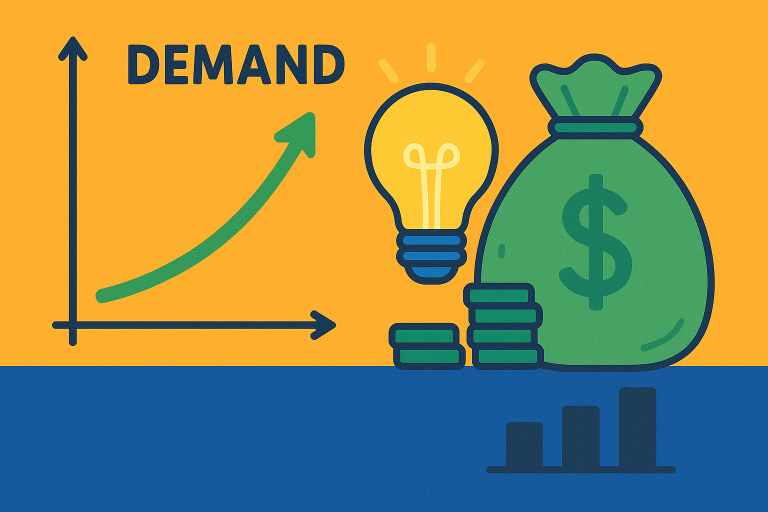The principle of effective demand is the central idea in Keynesian economics that income and employment levels are determined by total demand in an economy. It argues that supply does not create its own demand. Instead, it’s the spending decisions of households, businesses, and governments that drive economic activity. When demand increases, production and jobs also rise.
Meaning and Definition of Effective Demand
Effective demand is not just about desire or need but actual spending power backed by willingness to pay. It signifies how much consumers and investors are ready to spend at a particular income level. British economist John Maynard Keynes introduced this term in his book The General Theory of Employment, Interest and Money.
- Effective demand = Aggregate demand at full employment
It refers to the amount of goods and services that people are ready to buy at a particular income level when the economy is fully employed. - It is the key to determining national income and output
The level of effective demand directly affects the income of the country and the volume of production of goods and services. - It affects employment generation
A rise in effective demand leads to more production and, in turn, more employment. This is especially important in economies like India with a high population.
Features of the Principle of Effective Demand
This principle focuses on how demand, not supply, controls the economy in the short run. It links spending directly with national income and employment levels. The concept helps explain business cycles, like booms and recessions. It shows how demand must be strong for full employment to exist.
- Focus on demand side
This principle looks at how consumer demand drives the economy rather than how much is produced. Demand determines supply, not the other way around. - Determines employment level
Employment depends on how much goods and services are demanded. If demand falls, jobs are lost; if it rises, jobs are created. - Short-run perspective
Keynes focused on the short run where prices and wages are sticky. In the short run, demand changes affect output and employment quickly. - Marginal Propensity to Consume (MPC)
MPC influences effective demand. If people spend more from their income, effective demand increases, leading to growth. - Influences investment decisions
Businesses look at effective demand before deciding to invest. If demand is strong, they invest more and produce more.
Determinants of Effective Demand
Effective demand is made up of different kinds of spending in the economy. It depends on what people buy, what businesses invest, and how much the government and foreign countries spend. All these actions together decide the total demand. When any one of these increases, overall demand rises. This leads to more jobs and higher production.
- Consumption expenditure
This includes what households spend on goods and services. When people spend more, demand increases and boosts production and employment. - Investment expenditure
This includes money spent by businesses on capital goods. More investment means more jobs and income, increasing demand further. - Government spending
In India, public spending on infrastructure, welfare schemes, and subsidies increases effective demand, especially in rural areas. - Exports and foreign demand
Demand for Indian goods abroad adds to effective demand. A rise in exports means more income and job creation. - Interest rates
Lower interest rates make loans cheaper, encouraging people to borrow and spend more. This increases effective demand and economic growth.
Importance of the Principle of Effective Demand
The principle helps in solving real problems like unemployment and low production. It gives clear guidance on how to grow an economy, especially in a developing country like India. It helps governments take the right steps to boost demand during a slowdown. It also tells businesses when to invest more. This principle builds a strong base for economic planning.
- Explains unemployment
Keynes used this principle to explain why unemployment exists. When demand is low, producers cut jobs to save costs. - Guides government policy
It helps governments frame policies to boost demand. For example, during COVID-19, the Indian government gave stimulus packages to increase demand. - Improves production planning
Firms use effective demand to plan how much to produce. It avoids overproduction and wastage of resources. - Encourages balanced growth
By focusing on demand, both rural and urban sectors can grow together. This is essential for inclusive development in India. - Stabilizes the economy
Maintaining effective demand prevents sharp ups and downs in the economy. It helps maintain steady growth and employment.
Diagram of Effective Demand (AD = AS)
The principle can be shown using a simple diagram where Aggregate Demand equals Aggregate Supply. This point decides how much output and employment the economy will have. Below this point, the economy can increase output if demand rises. But once full employment is reached, more demand only causes prices to rise.
- The AD curve slopes upward showing that as income rises, people spend more.
- The AS curve in the short run is horizontal up to full employment, meaning prices stay fixed.
- The point where AD intersects AS is where effective demand exists. Beyond this point, output doesn’t rise.
Criticism of the Principle of Effective Demand
Though useful, this principle is not without flaws. Critics say it focuses only on the short run and ignores long-term development. It also doesn’t look at supply-side factors like technology or resources. In a country like India, where structural issues are deep, only increasing demand may not be enough. It can also lead to inflation if not handled carefully.
- Ignores supply-side economics
Critics say it overlooks factors like technology and production capacity, which are also important for growth. - Short-run theory
It does not offer long-term solutions for economic development. Indian policymakers often require long-term planning. - Assumes constant prices
It assumes prices and wages are fixed in the short run, which may not always hold true in developing economies like India. - Neglects inflation impact
Increase in demand can lead to inflation. This may reduce purchasing power, especially for poor and middle-class families.
Principle of Effective Demand FAQs
Q1. What is the principle of effective demand?
It states that employment and income depend on total spending in the economy. More demand means more jobs and output.
Q2. Who introduced the concept of effective demand?
British economist John Maynard Keynes introduced it in his famous book The General Theory in 1936.
Q3. How does effective demand affect unemployment?
Low effective demand leads to less production and higher unemployment. Increasing demand creates more jobs.
Q4. What are the key components of effective demand?
The main components are consumption, investment, government spending, and net exports.
Q5. Why is the principle of effective demand important in India?
India has large population and unemployment. Boosting effective demand helps generate jobs and improve income levels.


